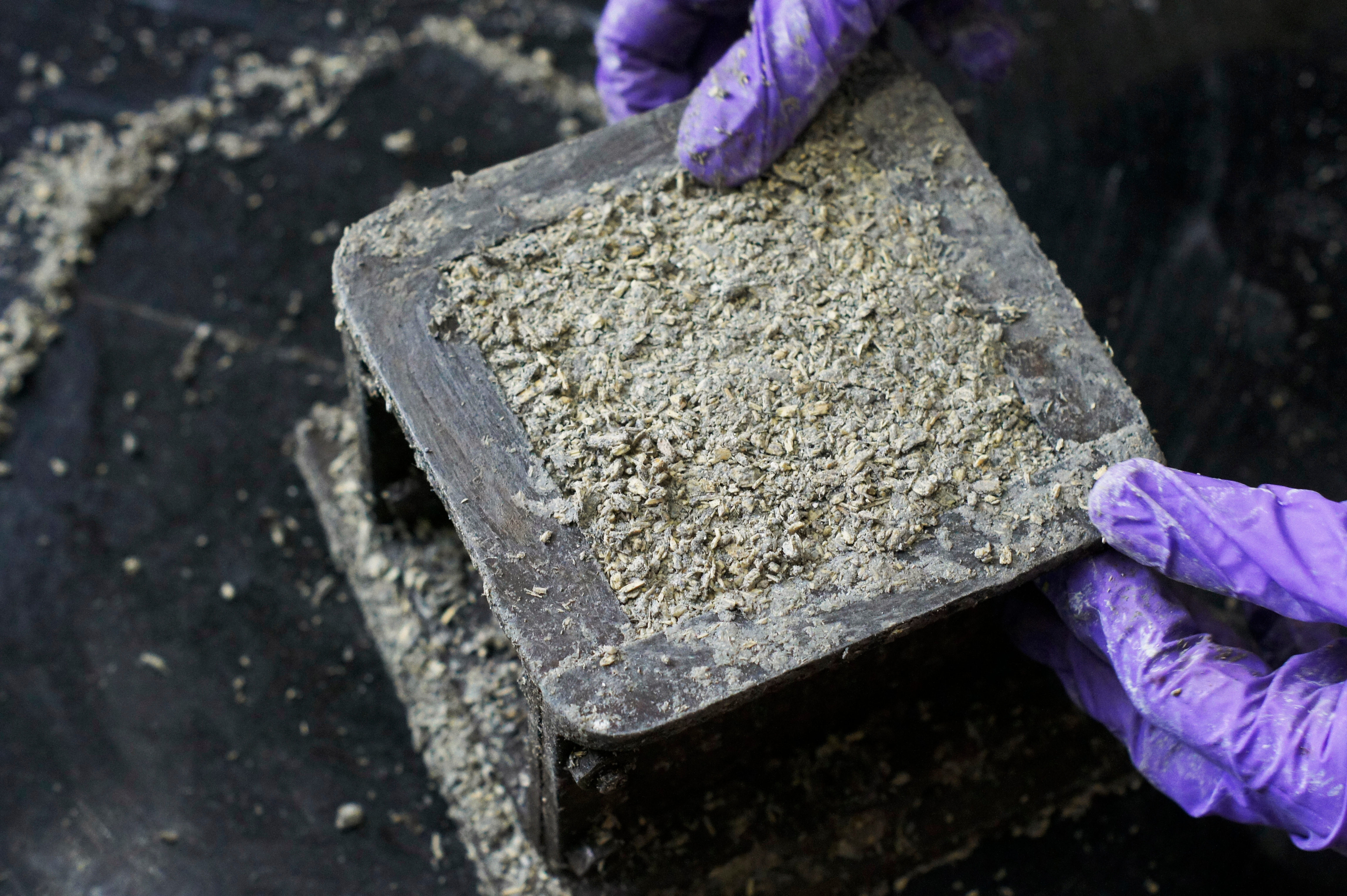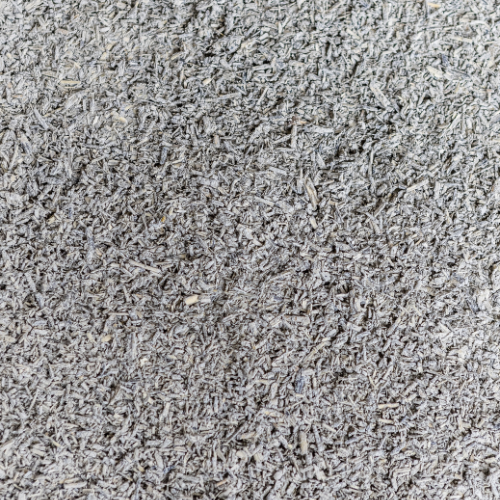Hempcrete is becoming increasingly popular in construction thanks to its impressive insulation properties and breathability, as well as its environmental benefits compared to traditional materials like concrete.
Made from a mixture of hemp shiv (hemp hurd) (the chopped hemp stalk) and lime, hempcrete is usually cast around a timber frame to make walls, floors, or ceilings, or applied to existing buildings as a retrofit insulation. Here’s what you need to know to get started with this unique eco-friendly material.
Mixing hempcrete
It’s best to mix hempcrete in a large forced action mixer, as the horizontal rotation of the mixing arms makes the hempcrete mixed better. The hempcrete materiel has a low density, so it will not drop fully to the bottom of a thumble mixer for mixing, decreasing the mixing effect. We recommend our 300 Liter forced action mixer as size does matter when mixing hempcrete. The output volume of hempcrete in liters is a lot lower than compared to concrete due to the product. Our 300 Liter forced action mixer is standard born with rubber shovels and a speed of 30 rounds per minute which fits the needs of mixing hempcrete.
Don’t improvise the quantities of hemp, lime, and water you use, as mixing exactly the right amount is critical if you want the hempcrete to form and dry properly. Follow the manufacturer’s instructions to the letter. An advantage when choosing a mixer is to have full visibility with the hempcrete mix – as with a SoRoTo forced action mixer.
The Dust Controller is recommended to add on the mixer, as the hempcrete in the mixing process emits a lot of dust. The SoRoTo Dust Controller removes up to 80% of the dust and keeps an open view of the material being mixed.
Don’t mix for any longer than prescribed from the product manufacturer - otherwise the binder will start clumping together into balls. To test whether it’s done, pick up a handful and prod it with your finger. It should come apart cleanly, without crumbling or feeling too moist. Once the hempcrete’s ready to go, use it quickly, and protect the mix from rain or direct sunlight. The SoRoTo H-Buckets are an efficient additional tool to optimize productivity as the unique locking system couples 2 buckets for a better (and more ergonomic) work height and due to their strong material, the H-Buckets are reusable for many years.

Building a hempcrete structure
If you commit to building the walls, floor, roof, and ceiling of a structure with hempcrete, you’ll reap the full benefits of its insulating properties. However, while strong, hempcrete isn’t load bearing, so you’ll first need to erect a timber frame to carry the weight of the building and support the walls.
To keep the hempcrete walls getting wet from rain or groundwater, you’ll need to build a plinth at their base. This plinth should be insulated, for example with load bearing thermal blocks, or it’ll act as a cold bridge around the building and curb hempcrete’s heat-retaining potential.
Hand-placing vs spraying
Hempcrete can either be cast by hand or by spraying. If you’re constructing a large building, spraying might be the right choice as it’s much more efficient, but hand-placing is generally preferred thanks to the simple, low-tech nature of the process.
Placing hempcrete
Before placing the hempcrete, you’ll need temporary shuttering that will stand-in for the hempcrete until it hardens - you can use plywood, steel, or plastic formwork. When applying the shuttering, make sure that it’s straight, as the hempcrete will follow its shape.
Place the hempcrete in layers between 10-15 centimeters thick, then spread and pat down the mixture carefully with a gloved hand. Compressing it more harshly or using a tool will reduce the air in the material, meaning it won’t insulate as well as it could.
Place the hempcrete in the shuttering, fixing more shuttering boards as you go. When you come to an opening such as a window, make the hempcrete about 2-3 centimeters taller than needed (unless you are an expert and know the exact volume/height needed) - you’ll then cut this back with a handsaw when the material has dried.
If it gets to the end of the day and you’re only halfway through filling a shuttering, taper the hempcrete down so that it makes a gradual slope. The next day, you can build on top of this, which will prevent creating a weakness in the wall.
Drying hempcrete
Hempcrete will usually dry in one or two weeks. Air and heat will speed up this time, so it’s best to cast at warmer times of year, and always make sure the walls aren’t blocked with equipment to maximise airflow/wind/sun light. Once the hempcrete is dry, you can cut back the excess at the windows (unless you are still the expert), and use a nail float to shape the hempcrete.
Adding finishes to hempcrete
Before adding finishes to the hempcrete make sure that all final fixings has been done/installed and that the hempcrete has dried to an acceptable level.
Fixings in the wall should either be made from stainless steel or hot dip galvanised, as the highly alkaline hemp-lime mixture will corrode other materials. Electrical wires can be run through the hempcrete wall so long as they are within a PVC or stainless steel conduit, and water and gas if inside a PVC conduit. These should be installed with the joints outside of the walls, so they can be easily accessed if needed.
Wet finishes can be applied as soon as there’s a small dry crust under the surface of the wall, which you can test with a moisture metre (we recommend a consistent reading of 25% of lower but if possible let the walls dry out as much as possible). Be careful not to plaster too early, as this can result in cosmetic damage. All the paints and finishes that are applied to a hempcrete wall need to be vapour permeable to protect the material.
What are you waiting for?
As a carbon sink (hemp absorbs more carbon from the atmosphere than it releases) with excellent insulation properties, hempcrete is a strong choice for masoners looking to harness the power of natural materials. There’s no better time than now to start learning how to build with hempcrete - it could play an important role in both the future of construction and the future of our world.
Disclaimer: The following blog text contains guidelines regarding hempcrete and how to mix it as communicated by the company SoRoTo. However, it is important to note that these guidelines are for informational purposes only and should not be considered as a substitute for the manufacturer's guidelines.
SoRoTo recommends that users always refer to the manufacturer's instructions and guidelines for their specific product to ensure proper and safe usage.
SoRoTo will not be held liable for any damages or injuries that may result from the misuse or improper application of their guidelines.
























